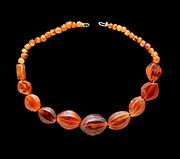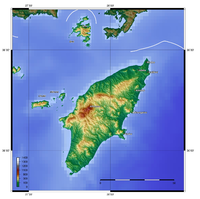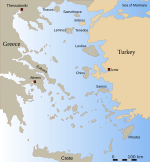Rhodes
Later Greek mythology recalled a Rhodian race called the Telchines and associated the island of Rhodes with Danaus; it was sometimes nicknamed Telchinis.In Pindar's ode, the island was said to be born of the union of Helios the sun god and the nymph Rhodos, and the cities were named for their three sons.[14] In the second half of the 8th century BC, the sanctuary of Athena received votive gifts that are markers for cultural contacts: small ivories from the Near East and bronze objects from Syria.At Kameiros on the northwest coast, a former Bronze Age site, where the temple was founded in the 8th century BC, there is another notable contemporaneous sequence of carved ivory figurines.The cemeteries of Kameiros and Ialyssos yielded several exquisite exemplars of the Orientalizing Rhodian jewelry, dated in the 7th and early 6th centuries BC.Its famous schools of philosophy, science, literature and rhetoric shared masters with Alexandria: the Athenian rhetorician Aeschines, who formed a school at Rhodes; Apollonius of Rhodes, who wrote about Jason and Medea in the Argonautica; the observations and works of the astronomers Hipparchus and Geminus; and the rhetorician Dionysius Thrax.Agesander of Rhodes, with two other Rhodian sculptors, carved the famous Laocoön group, now in the Vatican Museums, and the large sculptures rediscovered at Sperlonga in the villa of Tiberius, probably in the early Imperial period.[19] Throughout the 3rd century BC, Rhodes attempted to secure its independence and commerce, particularly its virtual control over the grain trade in the eastern Mediterranean.Consequently, the Rhodians pursued a policy of maintaining a balance of power among the Antigonids, Seleucids, and Ptolemies, even if that meant going to war with its traditional ally, Egypt.It extended roughly from the modern city of Muğla (ancient Mobolla) in the north and Kaunos bordering Lycia in the south, near the present-day Dalyan, Turkey.The result was the Second Macedonian War (200–196 BC), which Rome won and greatly reduced Macedon's power, prestige, and territory.Having provided Rome with valuable naval help in her first foray into Asia, the Rhodians were rewarded with territory and enhanced status by the Treaty of Apamea (188 BC).[23] The Romans once again evacuated the east – the Senate preferred clients to provinces – but it was clear that Rome now ruled the Mediterranean and Rhodian autonomy was ultimately dependent upon good relations with them.[24] Rhodes remained scrupulously neutral during the war, but in the view of hostile elements in the Senate she had been a bit too friendly with the defeated King Perseus.In 164 BC, Rhodes became a "permanent ally" of Rome, which was essentially a reduction to client state of nominal but meaningless independence.When their fleet was destroyed by Greek fire before Constantinople and by storms on its return trip, however, the Umayyads evacuated their troops in 679/80 as part of the Byzantine–Umayyad peace treaty.As Byzantine central power weakened under the Angeloi emperors (1185–1204), in the first half of the 13th century, Rhodes became the centre of an independent domain under Leo Gabalas and his brother John,[27] until it was occupied by the Genoese in 1248–1250.Against this force the Knights, under Grand Master Philippe Villiers de L'Isle-Adam, had about 7,000 men-at-arms, with an English, Spanish, French, and Italian contingent each defending separate areas and their fortifications.Despite the defeat, both Christians and Muslims seem to have regarded the conduct of Villiers de L'Isle-Adam as extremely valiant, and the Grand Master was proclaimed a Defender of the Faith by Pope Adrian VI (see Knights of Cyprus and Rhodes).In the 19th century the island was populated by ethnic groups from the surrounding nations, including Jews, whose presence goes back 2,300 years.Outside the city of Rhodes, the island is dotted with small villages of whitewashed homes and spa resorts, among them Faliraki, Lindos, Kremasti, Haraki, Pefkos, Archangelos, Afantou, Koskinou, Embona (Attavyros), Paradisi, and Trianta (Ialysos).The interior of the island is mountainous, sparsely inhabited and covered with forests of pine (Pinus brutia) and cypress (Cupressus sempervirens).While the shores are rocky, the island has arable strips of land where citrus fruit, wine grapes, vegetables, olives and other crops are grown.The South East of the island experiences a significantly warmer climate with Lindos registering a mean annual temperature of around 22.0 °C (71.6 °F),[47] making it the warmest area in Greece.[48][49] Moreover, according to the Hellenic National Meteorological Service, South East Rhodes records the highest mean annual sunshine in Greece with over 3,100 hours.Kahal Shalom has been renovated with the help of foreign donors but few Jews live year-round in Rhodes today, so services are not held on a regular basis.Diagoras Airport, southwest of Rhodes City, is the fourth biggest by passenger volume in Greece, and the main entrance/exit point to the island for both locals and tourists.These are the four major island arteries: Future roads:[citation needed] Bus services are handled by two operators:[78] Families in Rhodes often own more than one car, along with a motorbike.Traffic jams are common particularly in the summer months as vehicles more than double while parking spots downtown and around the old town are limited and can't cope with demand.Guests from Great Britain, Israel, France, Italy, Sweden and Norway are the ones that constitute the biggest portion in terms of the arrivals by country.




































Rhodes (disambiguation)Rhode (disambiguation)Rhode Island (disambiguation)Rodi (disambiguation)IslandmunicipalityGreeceAdministrative regionSouth AegeanPrefectureDodecaneseRegional unitRhodesAttavyrosDemonym(s)Time zonePostal codesTelephoneromanizedMediterranean SeaRhodes regional unitcity of RhodesAthensKnights of Saint John of JerusalemColossus of RhodesSeven Wonders of the Ancient WorldThe Medieval Old Town of the City of RhodesWorld Heritage SiteAncient GreekItalianTurkishLadinoTelchinisThe Travels of Sir John MandevilleEpistle to the ColossiansColossaePhoenicianNeolithicMinoan civilizationMinoansTelchinesDanausDoric HexapolisMycenaean GreeceGreek Dark AgesKattaviaMycenaean GreeksBronze Age collapseCyprusTrojan WarTlepolemusArchaic GreeceCamirusDoriansLindusIalysusCnidusHalicarnassusDorian HexapolisPindarHeliosRhodoshibiscusDiodorus SiculusHeliopolisastrologyKameirosAcropolis of RhodesClassical GreecePersiansAthenian LeaguePeloponnesian Warunited to form one territoryStraboHippodamusMausolusHellenistic GreeceGreece in the Roman eraAlexander the GreatDiadochiPtolemySeleucusAntigonusAlexandriarhetoricAeschinesApollonius of RhodesArgonauticaHipparchusGeminusDionysius ThraxPergameseHellenisticBaroqueAgesander of RhodesLaocoön groupVatican Museumslarge sculptures rediscovered at SperlongaTiberiusImperial periodDemetriusbesiege Rhodessiege enginesbattering ramsiege towerHelepolisHalieiagrain tradeRhodian PeraiaMuğlaKaunosDalyanPhilip VAntiochus IIIchecked Philip's navyRoman RepublicLindosdrachmaSecond Punic WarHannibalFirst Macedonian WarSecond Macedonian WarCycladesSecond Nesiotic LeagueRoman–Seleucid WarTreaty of Apamea

